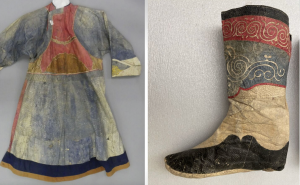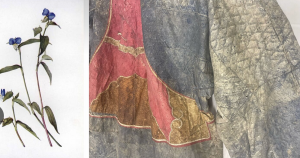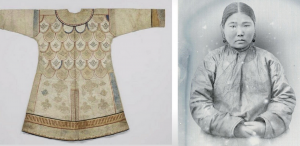AMUR RIVER FISH SKIN NATURAL DYES
at the 43rd International Conference on Dyes in History and Archaeology, held at Cloth Hall Court in Leeds and organised by Society of Dyers and Colourists. It was an wonderful opportunity to present my research on Dye Plants Used in Fish Skin Artefacts by the Nivkh and Nanai Indigenous Peoples of the Amur River.
I would like to specially thank Joanne Dyer of the DHA43 Scientific Committee for her constant support and inspiration throughout this journey. My deepest gratitude to Shelley Hollingdrake and Andrew Filarowski from the Society of Dyers and Colourists for their generous SDC Bursary Award, which made it possible for me to attend. Huge thanks to Diego Tamburini for his invaluable insights into the potential sources of yellow dyes along the Amur River. All my gratitude to Anatoly Donkan for sharing all his invaluable knowledge.
The conference was a fantastic chance to connect with many wonderful colleagues and learn from their incredible knowledge. I am now fully energised to continue this research and work on the forthcoming publication.
Red, blue, yellow and black were the predominant colours in Amur decorative elements. Natural dyes played a crucial role in ornamentation. Minerals were collected from the Amur River shores, ground with dry red caviar, and diluted with water for use. Orange-red hues were created from natural earth pigment or ochre, which was soaked in fish blood and heated. Safflower petals, introduced from the Silk Route around the 3rd century C.E., were used for their pure red dye despite the low red component concentration, while the higher concentration yellow components were discarded for lack of lightfastness. Black was produced from carbon black. Indigo blue was obtained from knotweed, successfully cultivated in Russian territories by 1835. Natural commelinin, obtained from the petals of the Asiatic dayflower has been used as early as the 11th century as blue dye.
- THE DEEP DIG UPENN MUSEUM
- MAPPING RACE THROUGH ARCTIC FISH SKIN ARTEFACTS
- ADORNMENTS FROM THE SEA
- AMUR RIVER FISH SKIN NATURAL DYES
- ARCTIC INUKSUIT STONES
- SPIRIT AND SKIN
- ART BIO MATTERS
- TRADITIONAL DYES FOR FISH LEATHER
- FISH WASTE FOR PROFIT
- FISHSKIN PATTERN-BASED GARMENTS
- A VIRTUAL AINU FISHSKIN WORKSHOP
- ARCTIC INDIGENOUS FISHSKIN
- SOCIETY OF LEATHER TECHNOLOGISTS
- COSTUME SOCIETY OF AMERICA
- IFFTI CONFERENCE 2020
- DESIGN MUSEUM CONFERENCE LONDON
- KYOTO SEIKA UNIVERSITY
- CRAFT CONFERENCE ESTONIA
- CUMULUS ROVANIEMI 2019
- MILANO DESIGN WEEK
- SIMON FRASER UNIVERSITY VANCOUVER
- BRITISH COUNCIL CRAFTING FUTURES
- EU INDUSTRY DAYS BRUSSELS
- LINEAPELLE INNOVATION TALKS
- EUROPEAN LEAGUE OF THE INSTITUTES OF THE ARTS
- DWEEK BILBAO AND BRITISH COUNCIL
- BRITISH ASSOCIATION FOR JAPANESE STUDIES
- TRANSBOUNDARY FASHION SEMINAR




